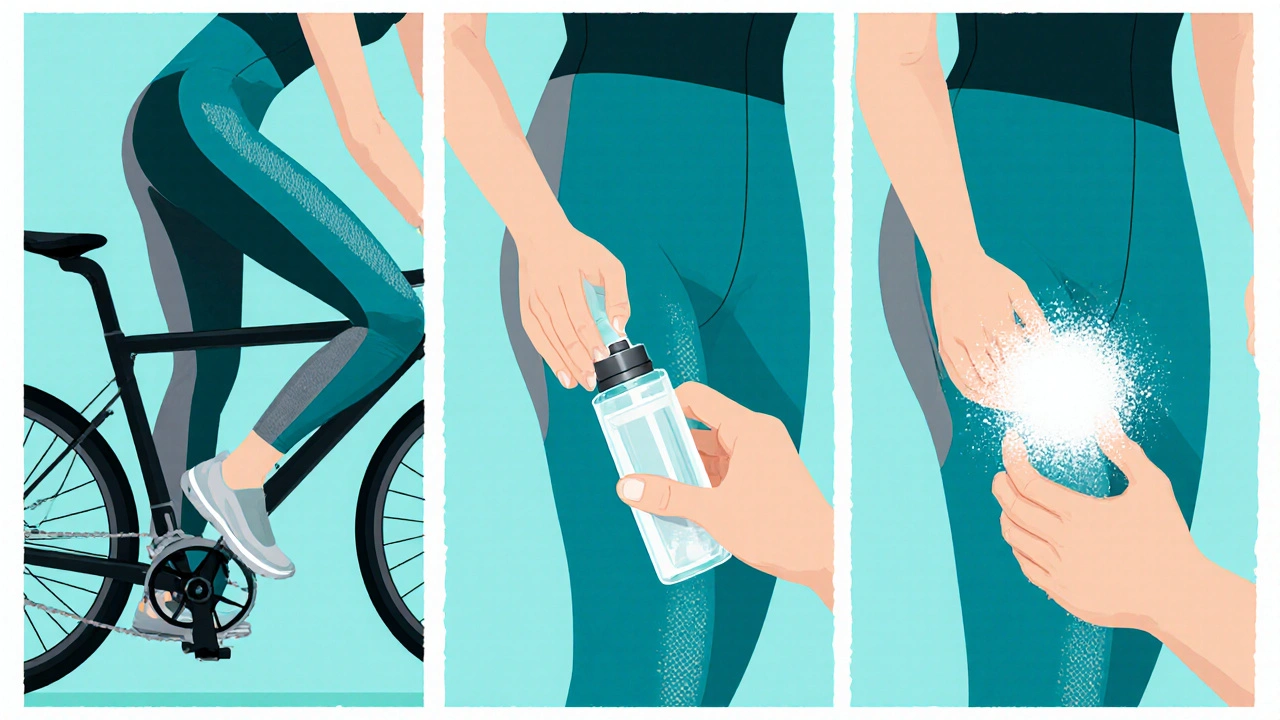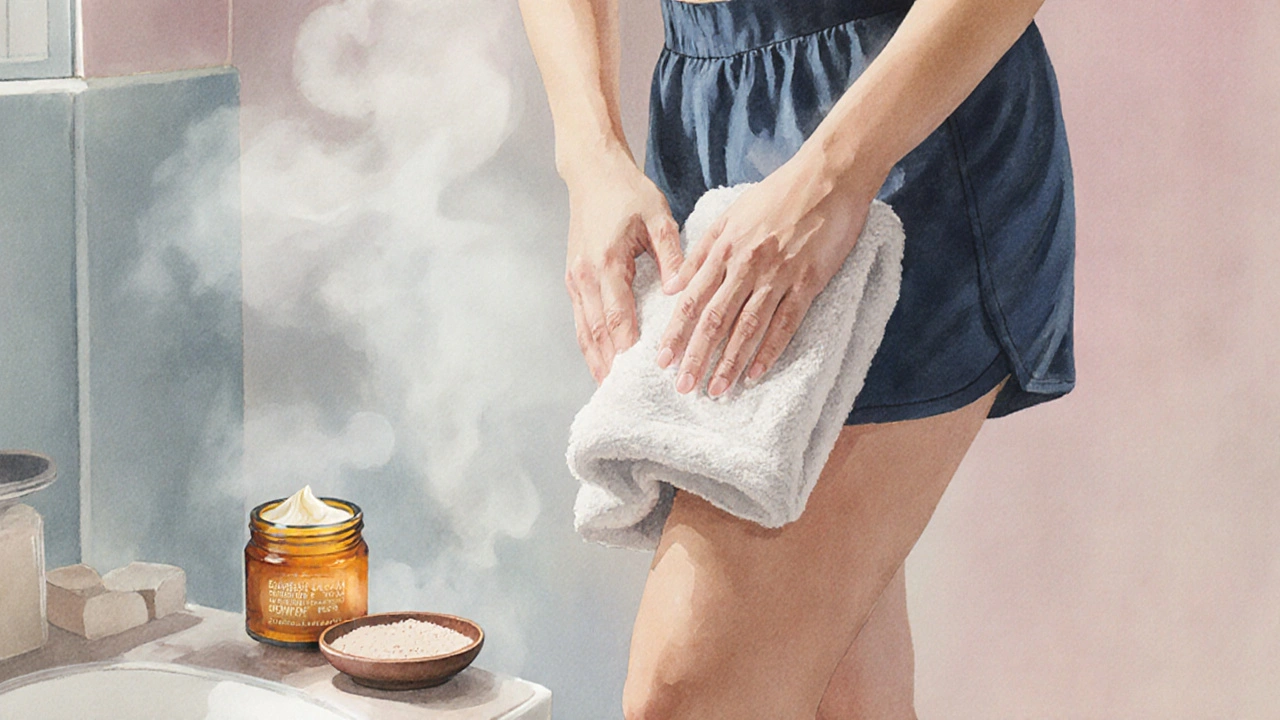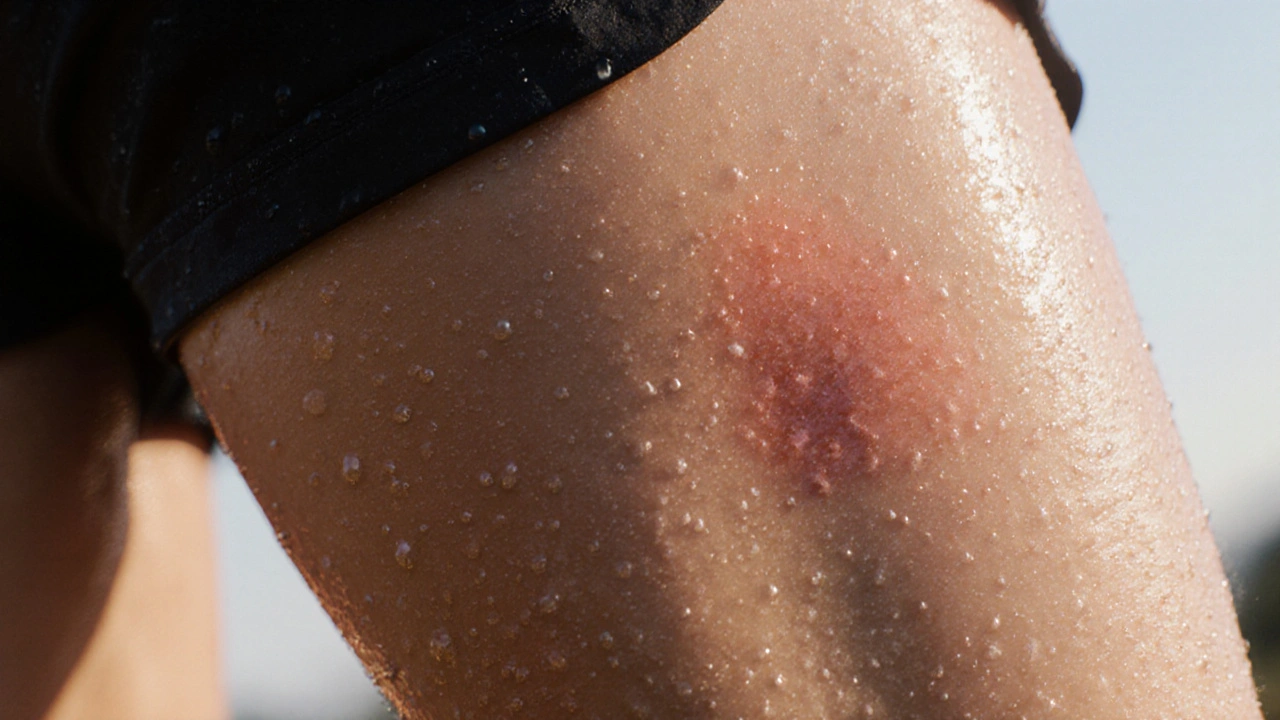Skin Chafe Risk Calculator
Your Chafe Risk Level
Ever notice how a good workout leaves you feeling great-until you start rubbing the backs of your thighs together and it hurts? That burning irritation is skin chafe, and more often than not sweat is the hidden culprit. Below you’ll find the science behind why moisture makes friction worse, plus practical stay dry tips you can use today.
Key Takeaways
- Moisture softens skin, increasing friction and leading to chafe.
- Temperature, humidity, and fabric choice are the three biggest aggravators.
- Moisture‑wicking clothing, targeted antiperspirant, and body powder form a three‑step defense.
- Barrier creams work best for high‑intensity activities or hot climates.
- Cleaning and drying the skin promptly prevents infection and reduces future chafe.
What Is Sweat?
Sweat is a clear, salty fluid produced by eccrine and apocrine glands to regulate body temperature. When your core temperature rises, these glands release sweat onto the skin surface, where evaporation cools you down. In a typical 30‑minute jog, a person can lose up to half a liter of fluid, and that moisture doesn’t just evaporate-it pools in skin folds, seams, and under tight clothing.
How Sweat Turns Into Skin Chafe
The moment sweat wets the skin, a chain reaction starts. Moisture softens the outermost layer (the stratum corneum), making it less resistant to shear forces. When you move, the softened skin slides against fabric or another skin surface, creating friction. That friction breaks down the skin’s protective barrier, leading to the red, raw patches we call chafe.
Core Factors That Worsen Chafe
- Humidity: High ambient humidity slows evaporation, leaving sweat on the surface longer.
- Clothing Fit: Tight seams or rough seams increase localized pressure points.
- Activity Type: Repetitive motion (running, cycling, hiking) repeats the friction cycle.
- Skin Condition: Dry, flaky skin is already compromised; sweat adds extra moisture that can cause it to split.

Moisture‑Wicking Fabrics: Your First Line of Defense
Moisture‑wicking fabric is a synthetic or blended textile engineered to pull sweat away from the skin and disperse it across a larger surface area for faster evaporation.Common fibers include polyester, nylon, and blends that feature micromesh channels. The result? Less sweat pooling directly on the skin, which means less friction.
Targeted Antiperspirant Use
Antiperspirant contains aluminum‑based compounds that temporarily block sweat ducts, reducing the amount of sweat that reaches the surface.It works best when applied at night, allowing the active ingredients to absorb into the sweat glands. Apply a thin layer to high‑risk zones-inner thighs, underarms, and the belly button-before bed. Re‑apply in the morning if you expect a long, sweaty session.
Powder Power: Body Powder and Its Role
Body powder absorbs residual moisture and reduces friction by creating a dry, low‑shear surface.Talc‑free options use cornstarch, arrowroot, or kaolin clay. Lightly dust the problem areas after showering and again before activity. Avoid over‑applying; a thin, even layer is enough.
Barrier Creams and Lubricants
Barrier cream forms a protective film that reduces direct skin‑to‑fabric contact.Ingredients such as dimethicone, petrolatum, or zinc oxide are common. Choose a silicone‑based product for a non‑greasy feel, especially if you’ll be in hot, humid conditions.

Choosing the Right Clothing: A Quick Comparison
| Attribute | Moisture‑Wicking | Cotton | Blended (Cotton/Polyester) |
|---|---|---|---|
| Absorption | Low - pulls sweat away | High - holds sweat | Medium - mixed behavior |
| Dry‑down Time | 5‑10 minutes | 30‑45 minutes | 15‑20 minutes |
| Friction Rating (1-5) | 1 (smooth) | 3 (moderate) | 2 (low‑moderate) |
| Ideal Use | Running, cycling, high‑heat | Casual, low‑sweat | Everyday active wear |
Post‑Activity Drying Routine
After a sweaty session, follow these steps to keep skin healthy:
- Shower with lukewarm water; avoid hot water which strips natural oils.
- Gently pat (don’t rub) the skin dry with a soft towel.
- Apply a thin layer of barrier cream or body powder while skin is still slightly damp.
- Change into clean, dry, moisture‑wicking garments before any prolonged sitting.
Common Mistakes that Invite Chafe
- Using scented antiperspirants on sensitive areas - fragrance can irritate.
- Wearing cotton socks or shoes that retain moisture during long runs.
- Skipping the nighttime antiperspirant application - it reduces effectiveness.
- Over‑applying powder - clumps can increase friction instead of reducing it.
When Chafe Persists: Troubleshooting
If the redness turns into open sores, consider these next steps:
- Switch to a medical‑grade barrier ointment containing zinc oxide.
- Keep the area clean with an antiseptic wash twice daily.
- Limit high‑intensity activities for a few days to allow healing.
- Consult a dermatologist if infection signs appear (increased pain, pus, fever).
Frequently Asked Questions
Can I use regular deodorant as an antiperspirant?
Most deodorants only mask odor and don’t block sweat ducts. Look for products that specifically label themselves as antiperspirants; they contain aluminum salts that reduce sweat production.
Is it safe to apply powder directly to broken skin?
Avoid powder on open wounds; it can trap bacteria. Instead, use a sterile gauze and a fragrance‑free barrier ointment until the skin heals.
How often should I wash my moisture‑wicking clothes?
After each sweaty session. Use a gentle detergent and avoid fabric softeners, which can clog the wicking channels.
Do natural fabrics like bamboo work for chafe prevention?
Bamboo has decent wicking properties and is soft, but it may retain more moisture than engineered synthetics. For intense heat, stick with polyester‑based options.
Can I combine antiperspirant and powder?
Yes. Apply antiperspirant first (preferably at night), let it dry, then dust a light layer of powder before activity. This layering maximizes sweat reduction and moisture absorption.
By understanding how sweat creates a perfect storm for skin chafe and using the right combination of fabrics, antiperspirant, powder, and barrier creams, you can stay dry, comfortable, and free from painful irritation-no matter how intense the workout or how humid the day.


Michelle Wigdorovitz
October 7, 2025 AT 19:31When the sun’s beating down and you’re pushing through a long run, the first thing that trips me up is the sticky feeling between my thighs. I swear, the right underwear can be a game‑changer. Look for a blend with a little spandex and a moisture‑wicking finish – it pulls sweat away and keeps friction down. I also slap a thin layer of body glide on trouble spots before I head out. Trust me, you’ll thank yourself when you finish without a single red line.
Arianne Gatchalian
October 8, 2025 AT 23:18I get how uncomfortable chafing can be, especially when you’re trying to enjoy a hike. One thing that’s helped me is keeping the skin moisturized with a non‑greasy lotion before I start moving. It creates a barrier that reduces friction. Pair that with breathable, synthetic fabrics that move sweat away, and the whole experience feels smoother. Small tweaks like these make a big difference in staying comfortable.
Martin Gilmore
October 10, 2025 AT 03:05Listen up! If you’re still wearing 100% cotton tees in a humid marathon, you’re basically inviting a sweat‑soaked disaster!!! Switch to high‑tech synthetics, they breathe, they wick, they conquer! And stop using cheap powders that clump – get a proper anti‑chafe stick, it slides on like butter!!! Your skin will thank you, the crowd will cheer, and you’ll finish without walking like a zombie.
jana caylor
October 11, 2025 AT 06:51Let me break it down step by step so you can actually put this into practice. First, the foundation is the right fabric; you want something that pulls moisture away from your skin, like polyester blends with a bit of elastane for stretch. Second, keep the skin hydrated but not slick – a light, non‑oily moisturizer does the trick and prevents the skin from drying out, which is a major cause of friction. Third, apply a thin layer of a reputable anti‑chafe balm to high‑risk zones such as thighs, underarms, and the belly button area before you start moving. Fourth, make sure your clothing fits properly; nothing too tight that scrapes, and nothing too loose that bunches up. Fifth, after your workout, take a quick shower and pat dry with a soft towel instead of rubbing harshly, then reapply a soothing aloe‑based cream. Sixth, invest in quality undergarments that have flat seams; raised seams act like tiny sandpaper strips. Seventh, consider using moisture‑wicking socks with reinforced heels and toes if you’re on your feet a lot. Eighth, for long hikes, pack a small tube of body glide in your kit – it’s lightweight and lasts a long time. Ninth, remember to change out of sweaty clothes as soon as possible; lingering moisture is a breeding ground for chafing. Tenth, stay aware of your body’s signals; at the first hint of irritation, take a break to adjust or reapply protection. Eleventh, if you’re in a humid climate, carry a small towel to dab excess sweat, but don’t rub aggressively. Twelfth, keep your nails trimmed to avoid accidental scrapes. Thirteenth, if you’re prone to skin irritation, a gentle hypoallergenic detergent for washing your gear can reduce chemical irritants. Fourteenth, don’t underestimate the power of a good night’s sleep; rested skin recovers faster. Finally, experiment and fine‑tune these steps to what works best for you, because each body is unique. Follow these, and you’ll stay dry, comfortable, and ready for whatever challenge comes next.
Vijendra Malhotra
October 12, 2025 AT 10:38From my experience training for marathons across Delhi’s scorching heat, I learned that the combination of climate and fabric makes or breaks your comfort. Stick to lightweight, moisture‑wicking synthetic blends; cotton just holds onto the sweat and becomes a clingy mess. Use a thin layer of petroleum‑based anti‑chafe balm on the inner thighs – it creates a slick barrier that lasts for hours. Also, keep a spare set of dry shorts in your bag; changing out of a soaked pair prevents the skin from staying soaked against you.
Nilesh Barandwal
October 13, 2025 AT 14:25It’s simple: keep the skin dry, keep the fabric moving, and keep friction low. A concise routine of a quick spray of anti‑chafe spray, followed by breathable tights, works every time. Remember, moisture is the enemy.
Elise Smit
October 14, 2025 AT 18:11Practice proper hygiene; a clean body reduces chafing risk.
Sen Đá
October 15, 2025 AT 21:58It is advisable, in a formal sense, to employ garments constructed of high‑performance fibers, which possess inherent moisture‑wicking properties. Moreover, the application of a clinically tested anti‑chafe ointment to susceptible regions, prior to exertion, shall mitigate the incidence of skin irritation. Regular inspection of apparel for seam integrity is also recommended.
LEE DM
October 17, 2025 AT 01:45When you pair a good pair of compression shorts with a breathable top, you limit the amount of skin‑on‑skin contact that leads to chafing. Add a dash of anti‑chafe balm, and you’re set for long sessions without the usual discomfort.
mathokozo mbuzi
October 18, 2025 AT 05:31In analyzing the underlying causes of chafing, one must consider both environmental humidity and the mechanical friction generated by clothing seams. A systematic approach, employing moisture‑wicking textiles and preventive dermatological agents, yields optimal outcomes.
Penny X
October 19, 2025 AT 09:18It is a moral imperative to prioritize one’s health over fashion; thus, one should eschew decorative garments that compromise comfort in favor of functional attire designed to preserve the integrity of the epidermis.